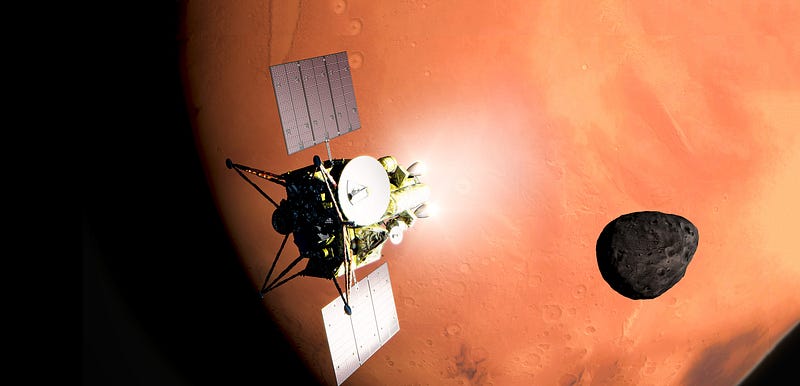Exploring Mars' Moons: The Ambitious MMX Mission by JAXA
Written on
Chapter 1: Introduction to the MMX Mission
Japan's space agency, JAXA, is gearing up for an unprecedented journey to study the moons of Mars. The Martian Moon Exploration (MMX) initiative aims to uncover significant information about Phobos and Deimos.
The Red Planet garners significant interest from the space exploration community, and for good reason. Positioned in the habitable zone of our solar system, Mars is considered the most likely candidate for supporting life and possesses a history of water alongside a dense atmosphere similar to Earth’s. However, there remains a lack of detailed knowledge regarding its two moons—Phobos and Deimos.
Understanding these Martian satellites is crucial, especially as humanity plans to send missions to Mars within the next twenty years. Investigating the moons could illuminate the formation of Mars and its celestial system, as well as their potential use as outposts for future deep space endeavors.
Phobos and Deimos spark curiosity among astronomers due to their resemblance to asteroids and their relatively small sizes, measuring 23 km and 12 km in diameter, respectively. Current hypotheses regarding their origins include the possibility that they were asteroids captured from the belt between Mars and Jupiter, or that they were formed from a planetary collision. Regardless of their origin, the upcoming exploration is anticipated to provide valuable data.
This paragraph will result in an indented block of text, typically used for quoting other text.
Section 1.1: The Importance of Phobos and Deimos
“Humans can realistically explore the surfaces of only a few objects, and Phobos and Deimos are on that list. Their position orbiting Mars makes them prime candidates for human visitation before we reach the surface of the Red Planet, but this will only be feasible once the results of the MMX mission have been analyzed.”
~ NASA Chief Scientist, Jim Green
While NASA is making plans to return to the Moon in search of liquid water, JAXA is implementing its strategy to explore the Martian moons. The Japanese government has initiated the Martian Moon eXploration (MMX) program, which has recently transitioned from the Pre-Project phase to the Project phase. The MMX mission is set to launch in 2024, with a return to Earth anticipated in 2029.
This mission builds on Japan's previous explorations, including the Hayabusa spacecraft’s journey to asteroid Itokawa, followed by Hayabusa2, which is currently on its way back to Earth after collecting a sample from asteroid Ryugu. While Hayabusa2 gathered a modest 0.1g sample, the MMX mission aims for a more ambitious target of 10g (0.35oz).
Subsection 1.1.1: Mission Objectives and Technology

The team will utilize 11 onboard instruments to remotely study the surfaces of both moons, with Phobos selected as the landing site for sample collection. A corer instrument capable of penetrating 2 cm (0.8 in) into the surface will be employed for this purpose.
In addition to studying the rocky surfaces, the mission aims to showcase the technology necessary for entering and exiting Mars’ gravitational field, deploying scientific instruments, and thoroughly examining the radiation environment—an essential consideration for human missions beyond Earth's protective magnetosphere.
Chapter 2: The Mission's Significance
The first video titled "Japan will explore Mars' moons in 2024 - TomoNews - YouTube" discusses JAXA’s plans for the MMX mission and the significance of exploring Phobos and Deimos in understanding Mars better.
The second video, "This New Martian Moon Mission Could Explain How Life Began - YouTube," elaborates on how the findings from MMX could offer insights into the origins of life on Earth and the broader implications for our understanding of life in the universe.